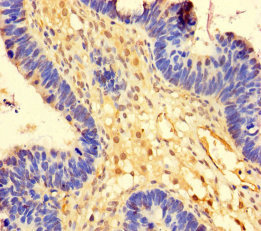
Western blot All lanes: OTUB1 antibody at 2microg/ml Lane 1: EC109 whole cell lysate Lane 2: 293T whole cell lysate Secondary Goat polyclonal to rabbit IgG at 1/15000 dilution Predicted band size: 32, 36 kDa Observed band size: 80 kDa
OTUB1 Antibody
CSB-PA03595A0RB
ApplicationsWestern Blot, ELISA, ImmunoHistoChemistry
Product group Antibodies
ReactivityHuman
TargetOTUB1
Overview
- SupplierCusabio
- Product NameOTUB1 Antibody
- Delivery Days Customer20
- ApplicationsWestern Blot, ELISA, ImmunoHistoChemistry
- CertificationResearch Use Only
- ClonalityPolyclonal
- ConjugateUnconjugated
- Gene ID55611
- Target nameOTUB1
- Target descriptionOTU deubiquitinase, ubiquitin aldehyde binding 1
- Target synonymsHSPC263, OTB1, OTU1, ubiquitin thioesterase OTUB1, OTU domain, ubiquitin aldehyde binding 1, OTU domain-containing ubiquitin aldehyde-binding protein 1, OTU-domain Ubal-binding 1, deubiquitinating enzyme OTUB1, otubain-1, ubiquitin-specific protease otubain 1, ubiquitin-specific-processing protease OTUB1
- HostRabbit
- IsotypeIgG
- Protein IDQ96FW1
- Protein NameUbiquitin thioesterase OTUB1
- Scientific DescriptionHydrolase that can specifically remove Lys-48-linked conjugated ubiquitin from proteins and plays an important regulatory role at the level of protein turnover by preventing degradation. Regulator of T-cell anergy, a phenomenon that occurs when T-cells are rendered unresponsive to antigen rechallenge and no longer respond to their cognate antigen. Acts via its interaction with RNF128/GRAIL, a crucial inductor of CD4 T-cell anergy. Isoform 1 destabilizes RNF128, leading to prevent anergy. In contrast, isoform 2 stabilizes RNF128 and promotes anergy. Surprisingly, it regulates RNF128-mediated ubiquitination, but does not deubiquitinate polyubiquitinated RNF128. Deubiquitinates estrogen receptor alpha (ESR1). Mediates deubiquitination of Lys-48-linked polyubiquitin chains, but not Lys-63-linked polyubiquitin chains. Not able to cleave di-ubiquitin. Also capable of removing NEDD8 from NEDD8 conjugates, but with a much lower preference compared to Lys-48-linked ubiquitin. Plays a key non-catalytic role in DNA repair regulation by inhibiting activity of RNF168, an E3 ubiquitin-protein ligase that promotes accumulation of Lys-63-linked histone H2A and H2AX at DNA damage sites. Inhibits RNF168 independently of ubiquitin thioesterase activity by binding and inhibiting UBE2N/UBC13, the E2 partner of RNF168, thereby limiting spreading of Lys-63-linked histone H2A and H2AX marks. Inhibition occurs by binding to free ubiquitin: free ubiquitin acts as an allosteric regulator that increases affinity for UBE2N/UBC13 and disrupts interaction with UBE2V1. The OTUB1-UBE2N/UBC13-free ubiquitin complex adopts a configuration that mimics a cleaved Lys48-linked di-ubiquitin chain.
- ReactivityHuman
- Storage Instruction-20°C or -80°C
- UNSPSC41116161








